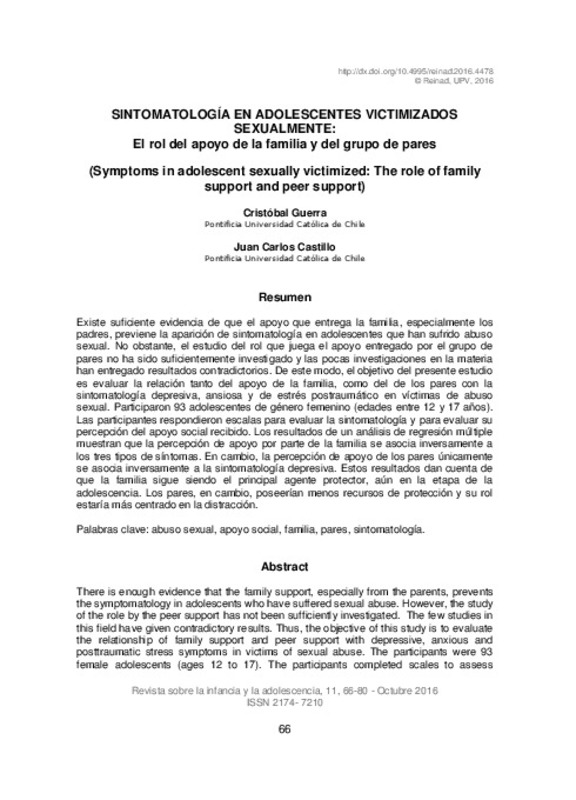JavaScript is disabled for your browser. Some features of this site may not work without it.
Buscar en RiuNet
Listar
Mi cuenta
Estadísticas
Ayuda RiuNet
Admin. UPV
Sintomatología en adolescentes victimizados sexualmente: El rol del apoyo de la familia y del grupo de pares
Mostrar el registro sencillo del ítem
Ficheros en el ítem
| dc.contributor.author | Guerra, Cristobal
|
es_ES |
| dc.contributor.author | Castillo, Juan Carlos
|
es_ES |
| dc.date.accessioned | 2016-11-04T10:48:50Z | |
| dc.date.available | 2016-11-04T10:48:50Z | |
| dc.date.issued | 2016-11-02 | |
| dc.identifier.uri | http://hdl.handle.net/10251/73287 | |
| dc.description.abstract | [EN] There is enough evidence that the family support, especially from the parents, prevents the symptomatology in adolescents who have suffered sexual abuse. However, the study of the role by the peer support has not been sufficiently investigated. The few studies in this field have given contradictory results. Thus, the objective of this study is to evaluate the relationship of family support and peer support with depressive, anxious and posttraumatic stress symptoms in victims of sexual abuse. The participants were 93 female adolescents (ages 12 to 17). The participants completed scales to assess symptoms and to assess their perception of social support. The results of multiple regression analysis show that the perception of support from family is inversely associated with all three types of symptoms. However, the perception of peer support is only inversely associated with depressive symptoms. These results show that the family remains the main protective agent, even in adolescence. The peer group possess fewer protection resources, for this reason its role would be more focused on distraction | es_ES |
| dc.description.abstract | [ES] Existe suficiente evidencia de que el apoyo que entrega la familia, especialmente los padres, previene la aparición de sintomatología en adolescentes que han sufrido abuso sexual. No obstante, el estudio del rol que juega el apoyo entregado por el grupo de pares no ha sido suficientemente investigado y las pocas investigaciones en la materia han entregado resultados contradictorios. De este modo, el objetivo del presente estudio es evaluar la relación tanto del apoyo de la familia, como del de los pares con la sintomatología depresiva, ansiosa y de estrés postraumático en víctimas de abuso sexual. Participaron 93 adolescentes de género femenino (edades entre 12 y 17 años). Las participantes respondieron escalas para evaluar la sintomatología y para evaluar su percepción del apoyo social recibido. Los resultados de un análisis de regresión múltiple muestran que la percepción de apoyo por parte de la familia se asocia inversamente a los tres tipos de síntomas. En cambio, la percepción de apoyo de los pares únicamente se asocia inversamente a la sintomatología depresiva. Estos resultados dan cuenta de que la familia sigue siendo el principal agente protector, aún en la etapa de la adolescencia. Los pares, en cambio, poseerían menos recursos de protección y su rol estaría más centrado en la distracción. | es_ES |
| dc.language | Español | es_ES |
| dc.publisher | Universitat Politècnica de València | |
| dc.relation.ispartof | Revista sobre la infancia y la adolescencia | |
| dc.rights | Reconocimiento - No comercial - Sin obra derivada (by-nc-nd) | es_ES |
| dc.subject | Abuso sexual | es_ES |
| dc.subject | Apoyo social | es_ES |
| dc.subject | Familia | es_ES |
| dc.subject | Sintomatología | es_ES |
| dc.subject | Pares | es_ES |
| dc.subject | Sexual abuse | es_ES |
| dc.subject | Social support | es_ES |
| dc.subject | Family | es_ES |
| dc.subject | Peer group | es_ES |
| dc.subject | Symptoms | es_ES |
| dc.title | Sintomatología en adolescentes victimizados sexualmente: El rol del apoyo de la familia y del grupo de pares | es_ES |
| dc.title.alternative | Symptoms in adolescent sexually victimized: The role of family support and peer support | es_ES |
| dc.type | Artículo | es_ES |
| dc.date.updated | 2016-11-03T13:27:03Z | |
| dc.identifier.doi | 10.4995/reinad.2016.4478 | |
| dc.rights.accessRights | Abierto | es_ES |
| dc.description.bibliographicCitation | Guerra, C.; Castillo, JC. (2016). Sintomatología en adolescentes victimizados sexualmente: El rol del apoyo de la familia y del grupo de pares. Revista sobre la infancia y la adolescencia. (11):66-80. https://doi.org/10.4995/reinad.2016.4478 | es_ES |
| dc.description.accrualMethod | SWORD | es_ES |
| dc.relation.publisherversion | https://doi.org/10.4995/reinad.2016.4478 | es_ES |
| dc.description.upvformatpinicio | 66 | es_ES |
| dc.description.upvformatpfin | 80 | es_ES |
| dc.type.version | info:eu-repo/semantics/publishedVersion | es_ES |
| dc.description.issue | 11 | |
| dc.identifier.eissn | 2174-7210 |








